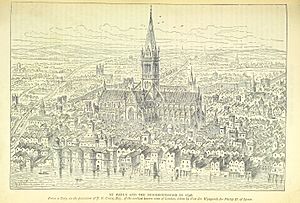Convocation of 1563 facts for kids
The Convocation of 1563 was a very important meeting of church leaders in England and Wales. It helped to make the religious rules of Queen Elizabeth I's reign stronger. This meeting also brought the Thirty-Nine Articles, which are a set of core beliefs for the Church of England, very close to their final form. The official version of these articles came out in 1571. This meeting was actually called the Convocation of 1562/3 for the province of Canterbury, and it began in January 1562 (using the old calendar).
Contents
What Happened at the Meeting?
Matthew Parker, who was the Archbishop of Canterbury, had prepared ideas for more changes in the Church of England. Other bishops also had their own plans. More than 30 people at the meeting wanted bigger changes. However, a less extreme plan, known as the "six articles," was almost approved but was narrowly voted down.
Because of this vote, the push for big changes to the Church through this official meeting slowed down. Archbishop Parker guided the meeting towards a middle path, often called the via media. This meant that ideas from reformers who were inspired by churches in Switzerland were not fully adopted.
The Convocation helped to make the Thirty-Nine Articles an important part of the Church of England. Before this, there were Forty-Two Articles from the time of Edward VI. These were shortened and became a draft at this meeting. Most people supported this new draft, and it became official after 1571.
Some reformers also suggested changes to church laws (called canon law) and how church services were done (called liturgy). Some of these ideas came from a group of bishops. But these ideas caused a lot of disagreement and did not pass. Later on, arguments about these same issues became a matter of who had authority in the Church.
Who Attended the Meeting?
Many important church leaders attended the Convocation of 1563. These included bishops and members of the Lower House of Convocation.
Bishops
Out of 20 bishops at the time, 12 of them had left England when Queen Mary was in power. They were known as "Marian exiles." Some bishops who stayed in England during Mary's reign had to hide their beliefs.
Nineteen bishops attended the start of the meeting. One bishop, Hugh Jones, attended as a representative for an older bishop.
Lower House Members
The Lower House of Convocation also had many members who had been exiles during Queen Mary's time. About 27 of them had lived outside England. Some historians believe there was a group of 34 strong reformers, sometimes called Puritans, in the Lower House.
Important members included deans, who are leaders of cathedrals, and archdeacons, who oversee church districts. There were also proctors, who represented the clergy (church officials) from different areas.
How the Meeting Worked
The Convocation meeting happened at the same time as a Parliament session. It took place in London, inside St Paul's Cathedral. The meetings ran from January 11 to April 14, 1563. The official opening was on January 12, but the real discussions started on January 13. On that day, a special prayer (the Litany) was sung, and a sermon was given in Latin.
The 39 Articles: Becoming Official
It took a while for the 39 Articles to become the official beliefs of the Church of England. There were different versions of the Articles. Some were handwritten from the Convocation, and others were printed in Latin and English by different printers in 1563.
In 1566, there was a plan in Parliament to make the articles from the Convocation official. However, Queen Elizabeth herself stopped this bill in the House of Lords. The Articles finally became fully official after 1571.


